Evaluation of the Continuous Monitoring of Land Disturbance Algorithm for Large-Scale Mangrove Classification
Abstract
1. Introduction
2. Materials and Methods
2.1. Study Areas
2.2. Niger Delta, Nigeria
2.3. Area around Cayenne, French Guiana
2.4. North Kalimantan, Borneo Island
2.5. Matang Forest Reserve, Malaysia
2.6. Gulf of Carpentaria, Australia
2.7. Data and Pre-Processing
2.7.1. Landsat Data
2.7.2. Auxiliary Data
Global Mangrove Watch Baseline
Elevation
Land/Water Masks
Distance to Water Rasters
2.8. Classification of Mangroves Using COLD
2.8.1. The COLD Algorithm
2.8.2. COLD Outputs
2.8.3. Model Training
2.8.4. Generation of Yearly Class Maps
2.9. Post-Processing
2.10. Validation
3. Results
3.1. Classification of Mangroves Using COLD
3.1.1. Niger Delta, Nigeria
3.1.2. Area around Cayenne, French Guiana
3.1.3. North Kalimantan, Borneo Island
3.1.4. Matang Forest Reserve, Malaysia
3.1.5. Gulf of Carpentaria, Australia
4. Discussion
4.1. Niger Delta, Nigeria
4.2. Area around Cayenne, French Guiana
4.3. North Kalimantan, Borneo Island
4.4. Matang Forest Reserve, Malaysia
4.5. Gulf of Carpentaria, Australia
4.6. Efficacy of the COLD Algorithm for Global Mangrove Monitoring
5. Conclusions
Author Contributions
Funding
Acknowledgments
Conflicts of Interest
Abbreviations
| ALOS-PALSAR | Advanced Land Observing Satellite Phased Array-type L-band Synthetic |
| Aperture Radar | |
| ARCSI | Atmospheric and Radiometric Correction of Satellite Imagery |
| BFAST | Breaks for Additive and Seasonal Trend |
| CCDC | Continuous Change Detection and Classification |
| COLD | Continuous Monitoring of Land Disturbance |
| DOF | Degrees of Freedom |
| DOY | Day of Year |
| EWMACD | Exponentially Weighted Moving Average Change Detection |
| ETM+ | Enhanced Thematic Mapper Plus |
| Fmask | Function of mask |
| GDAL | Geospatial Data Abstraction Library |
| GMW | Global Mangrove Watch |
| GOC | Gulf of Carpentaria |
| JERS-1 | Japanese Earth Resources Satellite |
| MFR | Matang Forest Reserve |
| NIR | Near Infrared |
| NDWI | Normalized Difference Water Index |
| ODC | Open Data Cube |
| OLI | Operational Land Imager |
| PPF | Percent Point Function |
| SCW | Super Computing Wales |
| SRTM | Shuttle Radar Topography Mission |
| SWIR | Shortwave Infrared |
| UAV | Unmanned Aerial Vehicle |
| USGS | United States Geological Survey |
References
- Giri, C.; Ochieng, E.; Tieszen, L.L.; Zhu, Z.; Singh, A.; Loveland, T.; Masek, J.; Duke, N. Status and distribution of mangrove forests of the world using earth observation satellite data. Glob. Ecol. Biogeogr. 2011, 20, 154–159. [Google Scholar] [CrossRef]
- Bunting, P.; Rosenqvist, A.; Lucas, R.M.; Rebelo, L.M.; Hilarides, L.; Thomas, N.; Hardy, A.; Itoh, T.; Shimada, M.; Finlayson, C.M. The global mangrove watch—A new 2010 global baseline of mangrove extent. Remote Sens. 2018, 10, 1669. [Google Scholar] [CrossRef]
- Kuenzer, C.; Bluemel, A.; Gebhardt, S.; Quoc, T.V.; Dech, S. Remote sensing of mangrove ecosystems: A review. Remote Sens. 2011, 3, 878–928. [Google Scholar] [CrossRef]
- Bandaranayake, W.M. Traditional and medicinal uses of mangroves. Mangroves Salt Marshes 1998, 2, 133–148. [Google Scholar] [CrossRef]
- Liao, J.; Zhen, J.; Zhang, L.; Metternicht, G. Understanding Dynamics of Mangrove Forest on Protected Areas of Hainan Island, China: 30 Years of Evidence from Remote Sensing. Sustainability 2019, 11, 5356. [Google Scholar] [CrossRef]
- Marois, D.E.; Mitsch, W.J. Coastal protection from tsunamis and cyclones provided by mangrove wetlands—A review. Int. J. Biodivers. Sci. Ecosyst. Serv. Manag. 2015, 11, 71–83. [Google Scholar] [CrossRef]
- Kristensen, E.; Bouillon, S.; Dittmar, T.; Marchand, C. Organic carbon dynamics in mangrove ecosystems: A review. Aquat. Bot. 2008, 89, 201–219. [Google Scholar] [CrossRef]
- Donato, D.C.; Kauffman, J.B.; Murdiyarso, D.; Kurnianto, S.; Stidham, M.; Kanninen, M. Mangroves among the most carbon-rich forests in the tropics. Nat. Geosci. 2011, 4, 293–297. [Google Scholar] [CrossRef]
- Feller, I.C.; Friess, D.A.; Krauss, K.W.; Lewis, R.R. The state of the world’s mangroves in the 21st century under climate change. Hydrobiologia 2017, 803, 1–12. [Google Scholar] [CrossRef]
- Ward, R.D.; Friess, D.A.; Day, R.H.; Mackenzie, R.A. Impacts of climate change on mangrove ecosystems: A region by region overview. Ecosyst. Health Sustain. 2016, 2, e01211. [Google Scholar] [CrossRef]
- Lovelock, C.E.; Cahoon, D.R.; Friess, D.A.; Guntenspergen, G.R.; Krauss, K.W.; Xuan, L. The vulnerability of Indo-Pacific mangrove forests to sea-level rise. Nature 2015, 526, 559–563. [Google Scholar] [CrossRef]
- Adegoke, J.O.; Fageja, M.; James, G.; Agbaje, G.; Ologunorisa, T.E. An Assessment of Recent Changes in the Niger Delta Coastline Using Satellite Imagery. J. Sustain. Dev. 2010, 3, 277. [Google Scholar] [CrossRef]
- Polidoro, B.A.; Carpenter, K.E.; Collins, L.; Duke, N.C.; Ellison, A.M.; Ellison, J.C.; Farnsworth, E.J.; Fernando, E.S.; Kathiresan, K.; Koedam, N.E.; et al. The loss of species: Mangrove extinction risk and geographic areas of global concern. PLoS ONE 2010, 5, e10095. [Google Scholar] [CrossRef] [PubMed]
- Mmom, P.C.; Arokoyu, S.B. Mangrove forest depletion, biodiversity loss and traditional resources management practices in the Niger Delta, Nigeria. Res. J. Appl. Sci. Eng. Technol. 2010, 2, 28–34. [Google Scholar]
- Richards, D.R.; Friess, D.A. Rates and drivers of mangrove deforestation in Southeast Asia, 2000–2012. Proc. Natl. Acad. Sci. USA 2016, 113, 344–349. [Google Scholar] [CrossRef]
- IPCC. Climate Change 2013: The Physical Science Basis. Contribution of Working Group I to the Fifth Assessment Report of the Intergovernmental Panel on Climate Change; Technical Report; Intergovernmental Panel on Climate Change: Geneva, Switzerland, 2013. [Google Scholar] [CrossRef]
- Gensac, E.; Lesourd, S.; Gardel, A.; Anthony, E.J.; Proisy, C.; Loisel, H. Short-term prediction of the evolution of mangrove surface areas: The example of the mud banks of Kourou and Sinnamary, French Guiana. J. Coast. Res. 2011, 388, 388–392. [Google Scholar]
- Giri, C.; Pengra, B.; Zhu, Z.; Singh, A.; Tieszen, L.L. Monitoring mangrove forest dynamics of the Sundarbans in Bangladesh and India using multi-temporal satellite data from 1973 to 2000. Estuar. Coast. Shelf Sci. 2007, 73, 91–100. [Google Scholar] [CrossRef]
- Ghosh, M.K.; Kumar, L.; Roy, C. Mapping long-term changes in mangrove species composition and distribution in the Sundarbans. Forests 2016, 7, 305. [Google Scholar] [CrossRef]
- Coppin, P.R.; Bauer, M.E. Digital Change Detection in Forest Ecosystems with Remote Sensing Imagery. Remote Sens. Rev. 1996, 13, 207–234. [Google Scholar] [CrossRef]
- Boyd, D.S.; Danson, F.M. Satellite remote sensing of forest resources: Three decades of research development. Prog. Phys. Geogr. 2005, 29, 1–26. [Google Scholar] [CrossRef]
- Mitchell, A.L.; Rosenqvist, A.; Mora, B. Current remote sensing approaches to monitoring forest degradation in support of countries measurement, reporting and verification (MRV) systems for REDD+. Carbon Balance Manag. 2017, 12, 1–22. [Google Scholar] [CrossRef]
- Heumann, B.W. Satellite remote sensing of mangrove forests: Recent advances and future opportunities. Prog. Phys. Geogr. 2011, 35, 87–108. [Google Scholar] [CrossRef]
- Giri, C. Observation and monitoring of mangrove forests using remote sensing: Opportunities and challenges. Remote Sens. 2016, 8, 783. [Google Scholar] [CrossRef]
- Wang, L.; Jia, M.; Yin, D.; Tian, J. A review of remote sensing for mangrove forests: 1956–2018. Remote Sens. Environ. 2019, 231. [Google Scholar] [CrossRef]
- Thomas, N.; Lucas, R.; Bunting, P.; Hardy, A.; Rosenqvist, A.; Simard, M. Distribution and drivers of global mangrove forest change, 1996–2010. PLoS ONE 2017, 12, e0179302. [Google Scholar] [CrossRef] [PubMed]
- Zhu, Z. Change detection using landsat time series: A review of frequencies, preprocessing, algorithms, and applications. ISPRS J. Photogramm. Remote Sens. 2017, 130, 370–384. [Google Scholar] [CrossRef]
- Verbesselt, J.; Hyndman, R.; Zeileis, A.; Culvenor, D. Phenological change detection while accounting for abrupt and gradual trends in satellite image time series. Remote Sens. Environ. 2010, 114, 2970–2980. [Google Scholar] [CrossRef]
- Brooks, E.B.; Wynne, R.H.; Thomas, V.A.; Blinn, C.E.; Coulston, J.W. On-the-fly massively multitemporal change detection using statistical quality control charts and landsat data. IEEE Trans. Geosci. Remote Sens. 2014, 52, 3316–3332. [Google Scholar] [CrossRef]
- Zhu, Z.; Woodcock, C.E. Continuous change detection and classification of land cover using all available Landsat data. Remote Sens. Environ. 2014, 144, 152–171. [Google Scholar] [CrossRef]
- Awty-Carroll, K.; Bunting, P.; Hardy, A.; Bell, G. Using Continuous Change Detection and Classification of Landsat Data to Investigate Long-Term Mangrove Dynamics in the Sundarbans Region. Remote Sens. 2019, 11, 2833. [Google Scholar] [CrossRef]
- Zhu, Z.; Zhang, J.; Yang, Z.; Aljaddani, A.H.; Cohen, W.B.; Qiu, S.; Zhou, C. Continuous monitoring of land disturbance based on Landsat time series. Remote Sens. Environ. 2019, in press. [Google Scholar] [CrossRef]
- Omo-Irabor, O.O.; Olobaniyi, S.B.; Akunna, J.; Venus, V.; Maina, J.M.; Paradzayi, C. Mangrove vulnerability modelling in parts of Western Niger Delta, Nigeria using satellite images, GIS techniques and Spatial Multi-Criteria Analysis (SMCA). Environ. Monit. Assess. 2011, 178, 39–51. [Google Scholar] [CrossRef]
- James, G.K.; Adegoke, J.O.; Osagie, S.; Ekechukwu, S.; Nwilo, P.; Akinyede, J. Social valuation of mangroves in the Niger Delta region of Nigeria. Int. J. Biodivers. Sci. Ecosyst. Serv. Manag. 2013, 9, 311–323. [Google Scholar] [CrossRef]
- Zabbey, N.; Ekpenyong, I.G.; Nwipie, G.N.; Davies, I.C.; Sam, K. Effects of fragmented mangroves on macrozoobenthos: A case study of mangrove clearance for powerline right-of-way at Oproama Creek, Niger Delta, Nigeria. Afr. J. Aquat. Sci. 2021, 46, 185–195. [Google Scholar] [CrossRef]
- Fromard, F.; Vega, C.; Proisy, C. Half a century of dynamic coastal change affecting mangrove shorelines of French Guiana. A case study based on remote sensing data analyses and field surveys. Mar. Geol. 2004, 208, 265–280. [Google Scholar] [CrossRef]
- Anthony, E.J.; Gardel, A.; Gratiot, N.; Proisy, C.; Allison, M.A.; Dolique, F.; Fromard, F. The Amazon-influenced muddy coast of South America: A review of mud-bank-shoreline interactions. Earth-Sci. Rev. 2010, 103, 99–121. [Google Scholar] [CrossRef]
- Proisy, C.; Mougin, E.; Fromard, F. Investigating correlations between radar data and mangrove forests characteristics. Int. Geosci. Remote Sens. Symp. (IGARSS) 1996, 1, 733–735. [Google Scholar] [CrossRef]
- Clive A, M.; Alex, J.; Alvaro, S.; Jozef, S.; Kerrie, W.; Meijaard, E.; Leonie, S.; Paul, D.; Douglas, S.; Haziq, N. Forest loss and Borneo’s climate. Environ. Res. Lett. 2018, 13, 044009. [Google Scholar]
- Wong, C.J.; James, D.; Besar, N.A.; Kamlun, K.U.; Tangah, J.; Tsuyuki, S.; Phua, M.H. Estimating Mangrove above-ground biomass loss due to deforestation in Malaysian Northern Borneo between 2000 and 2015 using SRTM and landsat images. Forests 2020, 11, 1018. [Google Scholar] [CrossRef]
- Rachmawani, D.; Yulianda, F.; Kusmana, C.; Boer, M. Study of Mangroves Ecosystem Management at Binalatung in Tarakan City of North Kalimantan. Int. J. Sci. Basic Appl. Res. (IJSBAR) 2016, 26, 221–234. [Google Scholar]
- Otero, V.; Van De Kerchove, R.; Satyanarayana, B.; Mohd-Lokman, H.; Lucas, R.; Dahdouh-Guebas, F. An analysis of the early regeneration of mangrove forests using Landsat time series in the matang mangrove forest reserve, Peninsular Malaysia. Remote Sens. 2019, 11, 774. [Google Scholar] [CrossRef]
- Otero, V.; Lucas, R.; Van De Kerchove, R.; Satyanarayana, B.; Mohd-Lokman, H.; Dahdouh-Guebas, F. Spatial analysis of early mangrove regeneration in the Matang Mangrove Forest Reserve, Peninsular Malaysia, using geomatics. For. Ecol. Manag. 2020, 472, 118213. [Google Scholar] [CrossRef]
- Abdul Aziz, A.; Phinn, S.; Dargusch, P.; Omar, H.; Arjasakusuma, S. Assessing the potential applications of Landsat image archive in the ecological monitoring and management of a production mangrove forest in Malaysia. Wetl. Ecol. Manag. 2015, 23, 1049–1066. [Google Scholar] [CrossRef]
- Goessens, A.; Satyanarayana, B.; Van Der Stocken, T.; Zuniga, M.Q.; Mohd-Lokman, H.; Sulong, I.; Dahdouh-Guebas, F. Is Matang Mangrove Forest in Malaysia sustainably rejuvenating after more than a century of conservation and harvesting management? PLoS ONE 2014, 9, e105069. [Google Scholar] [CrossRef] [PubMed]
- Duke, N.C.; Kovacs, J.M.; Griffiths, A.D.; Preece, L.; Hill, D.J.; Van Oosterzee, P.; Mackenzie, J.; Morning, H.S.; Burrows, D. Large-scale dieback of mangroves in Australia’s Gulf of Carpentaria: A severe ecosystem response, coincidental with an unusually extreme weather event. Mar. Freshw. Res. 2017, 68, 1816–1829. [Google Scholar] [CrossRef]
- Asbridge, E.; Lucas, R.; Ticehurst, C.; Bunting, P. Mangrove response to environmental change in Australia’s Gulf of Carpentaria. Ecol. Evol. 2016, 6, 3523–3539. [Google Scholar] [CrossRef]
- Kuenzer, C.; van Beijma, S.; Gessner, U.; Dech, S. Land surface dynamics and environmental challenges of the Niger Delta, Africa: Remote sensing-based analyses spanning three decades (1986–2013). Appl. Geogr. 2014, 53, 354–368. [Google Scholar] [CrossRef]
- Innocent Abbas, I. An Assessment of Land Use/Land Cover Changes in a Section of Niger Delta, Nigeria. Front. Sci. 2013, 2, 137–143. [Google Scholar] [CrossRef]
- Baird, J. Oil’s shame in Africa. Newsweek 2010, 156, 16. [Google Scholar]
- Gardel, A.A.; Gratiot, N. Monitoring of Coastal Dynamics in French Guiana from 16 Years of SPOT Satellite Images. J. Coast. Res. 2006, 3, 1502–1505. [Google Scholar]
- Walcker, R.; Anthony, E.J.; Cassou, C.; Aller, R.C.; Gardel, A.; Proisy, C.; Martinez, J.M.; Fromard, F. Fluctuations in the extent of mangroves driven by multi-decadal changes in North Atlantic waves. J. Biogeogr. 2015, 42, 2209–2219. [Google Scholar] [CrossRef]
- Gaveau, D.L.; Sloan, S.; Molidena, E.; Yaen, H.; Sheil, D.; Abram, N.K.; Ancrenaz, M.; Nasi, R.; Quinones, M.; Wielaard, N.; et al. Four decades of forest persistence, clearance and logging on Borneo. PLoS ONE 2014, 9, e101654. [Google Scholar] [CrossRef]
- Langner, A.; Miettinen, J.; Siegert, F. Land cover change 2002–2005 in Borneo and the role of fire derived from MODIS imagery. Glob. Chang. Biol. 2007, 13, 2329–2340. [Google Scholar] [CrossRef]
- Ibharim, N.A.; Mustapha, M.A.; Lihan, T.; Mazlan, A.G. Mapping mangrove changes in the Matang Mangrove Forest using multi temporal satellite imageries. Ocean Coast. Manag. 2015, 114, 64–76. [Google Scholar] [CrossRef]
- Abdul Aziz, A.; Phinn, S.; Dargusch, P. Investigating the decline of ecosystem services in a production mangrove forest using Landsat and object-based image analysis. Estuar. Coast. Shelf Sci. 2015, 164, 353–366. [Google Scholar] [CrossRef]
- Omar, H.; Misman, M.A.; Linggok, V. Characterizing and monitoring of mangroves in Malaysia using Landsat-based spatial-spectral variability. In Proceedings of the IOP Conference Series: Earth and Environmental Science, Kuala Lumpur, Malaysia, 24–25 April 2018; IOP Publishing: Bristol, UK, 2018; Volume 169, p. 012037. [Google Scholar] [CrossRef]
- Otero, V.; Van De Kerchove, R.; Satyanarayana, B.; Martínez-Espinosa, C.; Fisol, M.A.B.; Ibrahim, M.R.B.; Sulong, I.; Mohd-Lokman, H.; Lucas, R.; Dahdouh-Guebas, F. Managing mangrove forests from the sky: Forest inventory using field data and Unmanned Aerial Vehicle (UAV) imagery in the Matang Mangrove Forest Reserve, peninsular Malaysia. For. Ecol. Manag. 2018, 411, 35–45. [Google Scholar] [CrossRef]
- Harris, T.; Hope, P.; Oliver, E.; Smalley, R.; Arblaster, J.; Holbrook, N.; Duke, N.; Pearce, K.; Braganza, K.; Bindoff, N. Climate Drivers of the 2015 Gulf of Carpentaria Mangrove Dieback; Technical Report; Earth Systems and Climate Change Hub Technical Report No. 2; NESP Earth Systems and Climate Change Hub: Melbourne, Australia, 2017. [Google Scholar]
- Long, B.G.; Skewes, T.D. A technique for mapping mangroves with Landsat TM satellite data and geographic information system. Estuar. Coast. Shelf Sci. 1996, 43, 373–381. [Google Scholar] [CrossRef]
- Lymburner, L.; Bunting, P.; Lucas, R.; Scarth, P.; Alam, I.; Phillips, C.; Ticehurst, C.; Held, A. Mapping the multi-decadal mangrove dynamics of the Australian coastline. Remote Sens. Environ. 2020, 238, 111185. [Google Scholar] [CrossRef]
- United States Geological Survey. Landsat Collection 1. Available online: https://www.usgs.gov/land-resources/nli/landsat/landsat-collection-1 (accessed on 17 August 2021).
- Bunting, P.; Clewley, D. Atmospheric and Radiometric Correction of Satellite Imagery (ARCSI). Available online: https://remotesensing.info/arcsi/ (accessed on 4 October 2021).
- Zhu, Z.; Woodcock, C.E. Object-based cloud and cloud shadow detection in Landsat imagery. Remote Sens. Environ. 2012, 118, 83–94. [Google Scholar] [CrossRef]
- Ayers, D.; Oliver, S.; Woodcock, R.; Contributors. Open Data Cube. 2019. Available online: https://github.com/opendatacube/datacube-core (accessed on 23 August 2021).
- Lewis, A.; Lymburner, L.; Purss, M.B.J.; Brooke, B.; Evans, B.; Ip, A.; Dekker, A.G.; Irons, J.R.; Minchin, S.; Mueller, N.; et al. Rapid, high-resolution detection of environmental change over continental scales from satellite data—The Earth Observation Data Cube. Int. J. Digit. Earth 2016, 9, 106–111. [Google Scholar] [CrossRef]
- Zhu, Z.; Woodcock, C.E.; Holden, C.; Yang, Z. Generating synthetic Landsat images based on all available Landsat data: Predicting Landsat surface reflectance at any given time. Remote Sens. Environ. 2015, 162, 67–83. [Google Scholar] [CrossRef]
- McFeeters, S.K. Using the normalized difference water index (ndwi) within a geographic information system to detect swimming pools for mosquito abatement: A practical approach. Remote Sens. 2013, 5, 3544–3561. [Google Scholar] [CrossRef]
- McFeeters, S.K. The use of the Normalized Difference Water Index (NDWI) in the delineation of open water features. Int. J. Remote Sens. 1996, 17, 1425–1432. [Google Scholar] [CrossRef]
- GDAL/OGR Contributors. GDAL/OGR Geospatial Data Abstraction Software Library. Available online: https://gdal.org (accessed on 30 July 2019).
- Pedregosa, F.; Varoquaux, G.; Gramfort, A.; Michel, V.; Thirion, B.; Grisel, O.; Blondel, M.; Prettenhofer, P.; Weiss, R.; Dubourg, V.; et al. Scikit-learn: Machine Learning in Python. J. Mach. Learn. Res. 2011, 12, 2825–2830. [Google Scholar]
- Giri, C.; Long, J.; Abbas, S.; Murali, R.M.; Qamer, F.M.; Pengra, B.; Thau, D. Distribution and dynamics of mangrove forests of South Asia. J. Environ. Manag. 2015, 148, 101–111. [Google Scholar] [CrossRef] [PubMed]
- Pontius, R.G., Jr.; Millones, M. Death to Kappa: Birth of quantity disagreement and allocation disagreement for accuracy assessment. Int. J. Remote Sens. 2011, 32, 4407–4429. [Google Scholar] [CrossRef]
- Dice, L.R. Measures of the Amount of Ecologic Association Between Species. Ecology 1945, 26, 297–302. [Google Scholar] [CrossRef]
- Shao, Z.; Tang, P.; Wang, Z.; Saleem, N.; Yam, S.; Sommai, C. BRRNet: A fully convolutional neural network for automatic building extraction from high-resolution remote sensing images. Remote Sens. 2020, 12, 1050. [Google Scholar] [CrossRef]
- Innocent Abbas, I.; Johnson Fasona, M. Remote Sensing and Geographic Information Techniques: Veritable Tools for Land Degradation Assessment. Am. J. Geogr. Inf. Syst. 2012, 1, 1–6. [Google Scholar] [CrossRef][Green Version]
- Pastor-Guzman, J.; Dash, J.; Atkinson, P.M. Remote sensing of mangrove forest phenology and its environmental drivers. Remote Sens. Environ. 2018, 205, 71–84. [Google Scholar] [CrossRef]
- Chong, V.C. Sustainable utilization and management of Mangrove ecosystems of Malaysia. Aquat. Ecosyst. Health Manag. 2006, 9, 249–260. [Google Scholar] [CrossRef]
- Thomas, N.; Bunting, P.; Lucas, R.; Hardy, A.; Rosenqvist, A.; Fatoyinbo, T. Mapping Mangrove Extent and Change: A Globally Applicable Approach. Remote Sens. 2018, 10, 1466. [Google Scholar] [CrossRef]





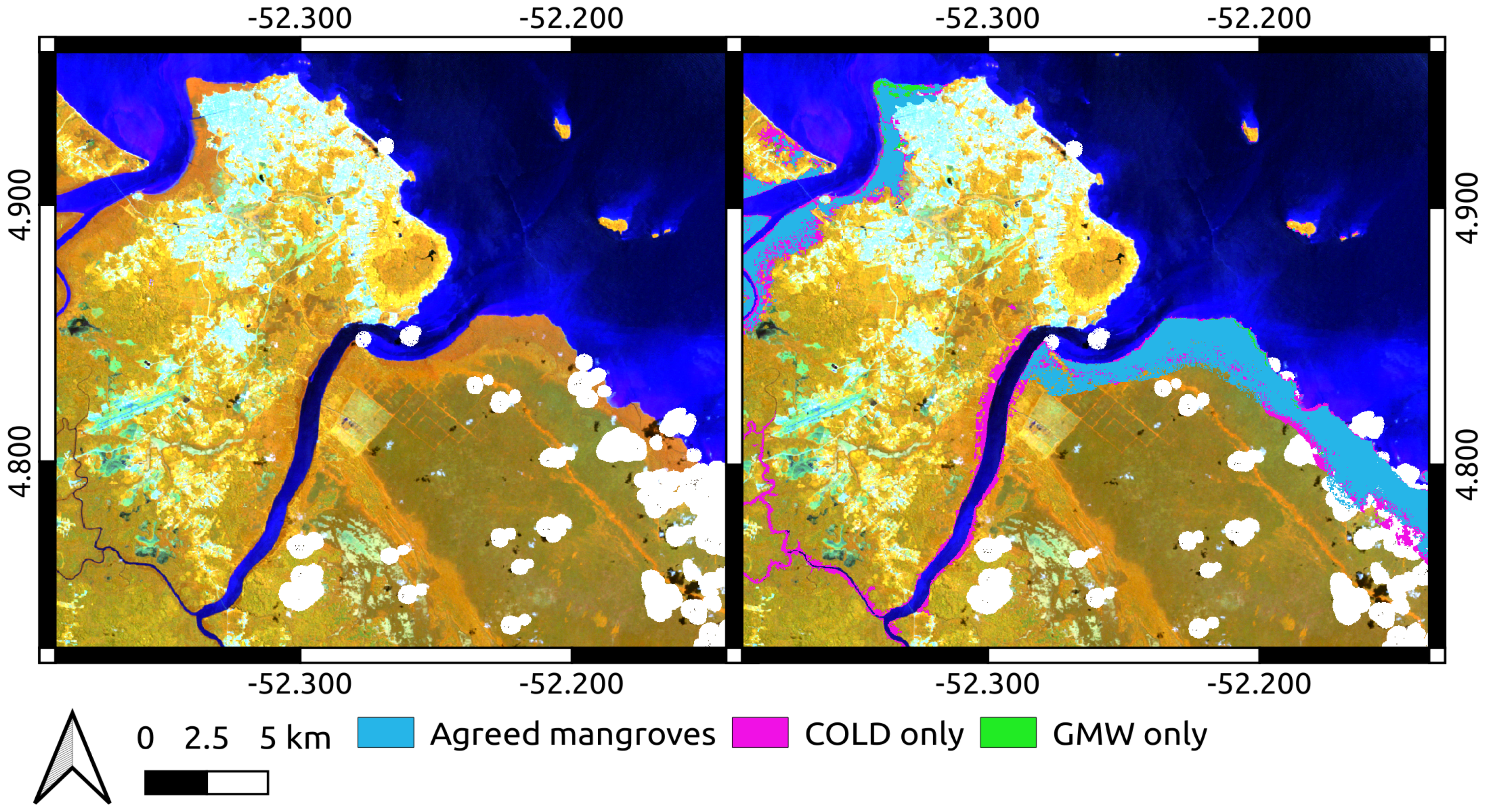
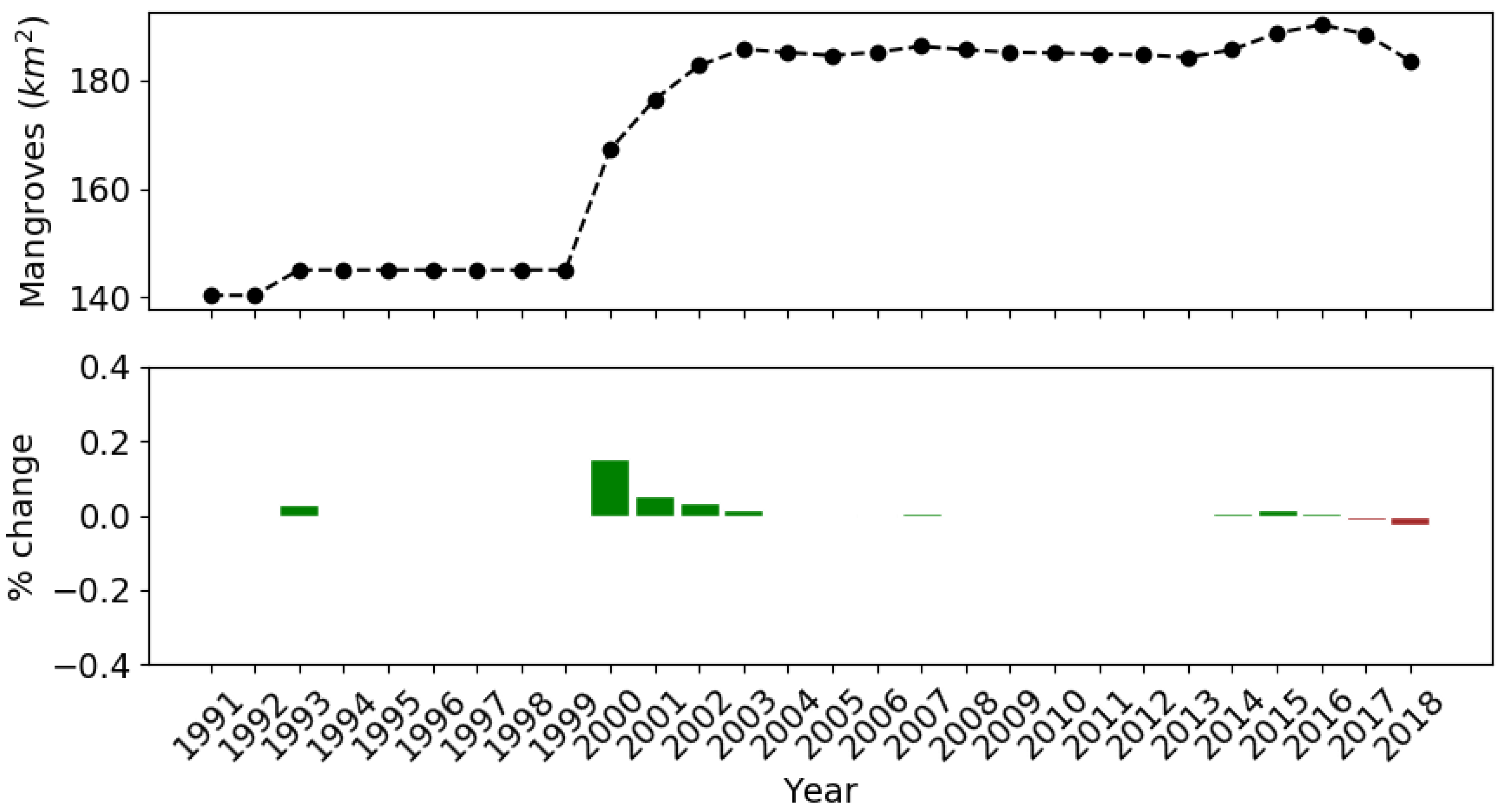

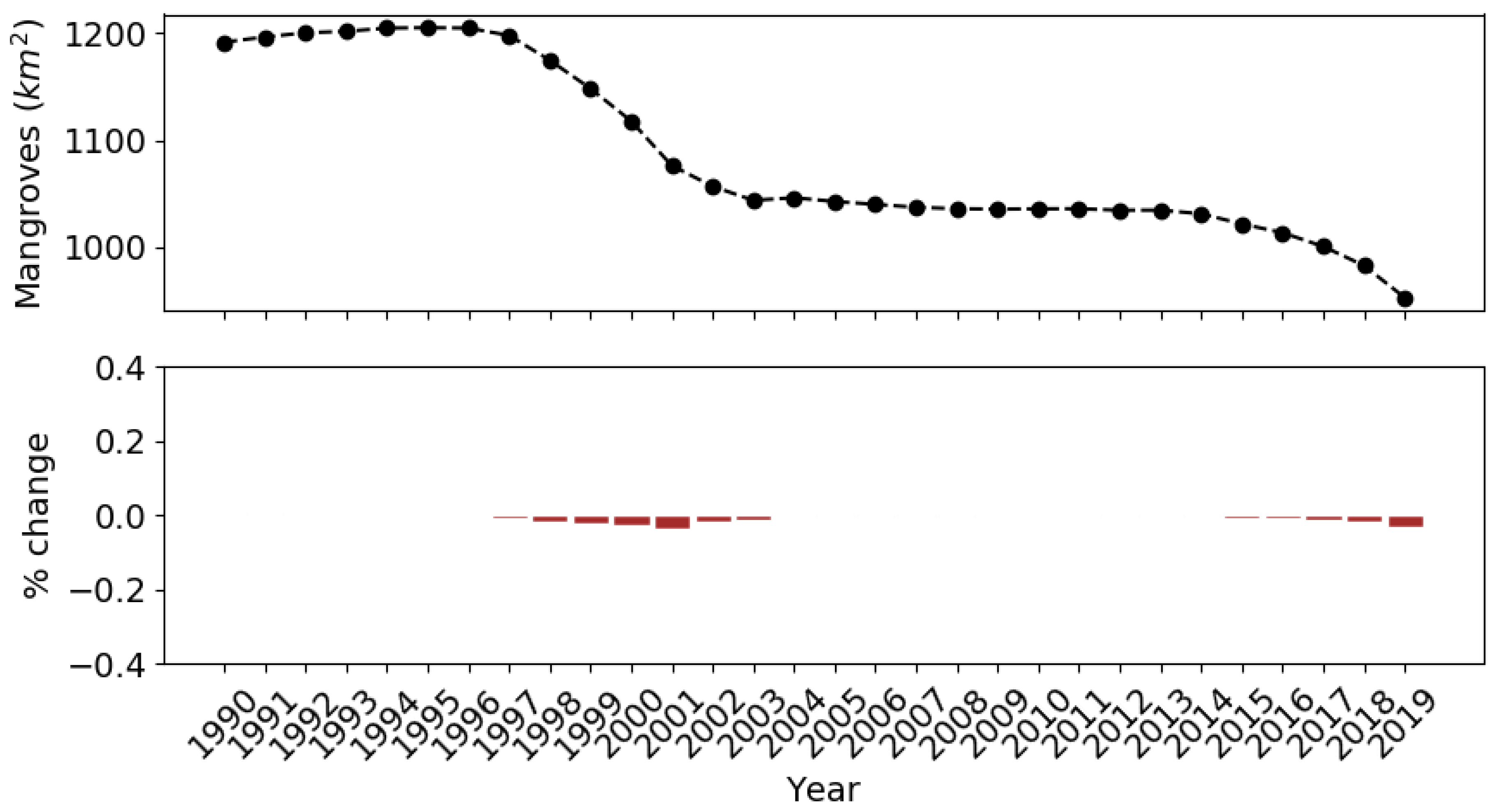
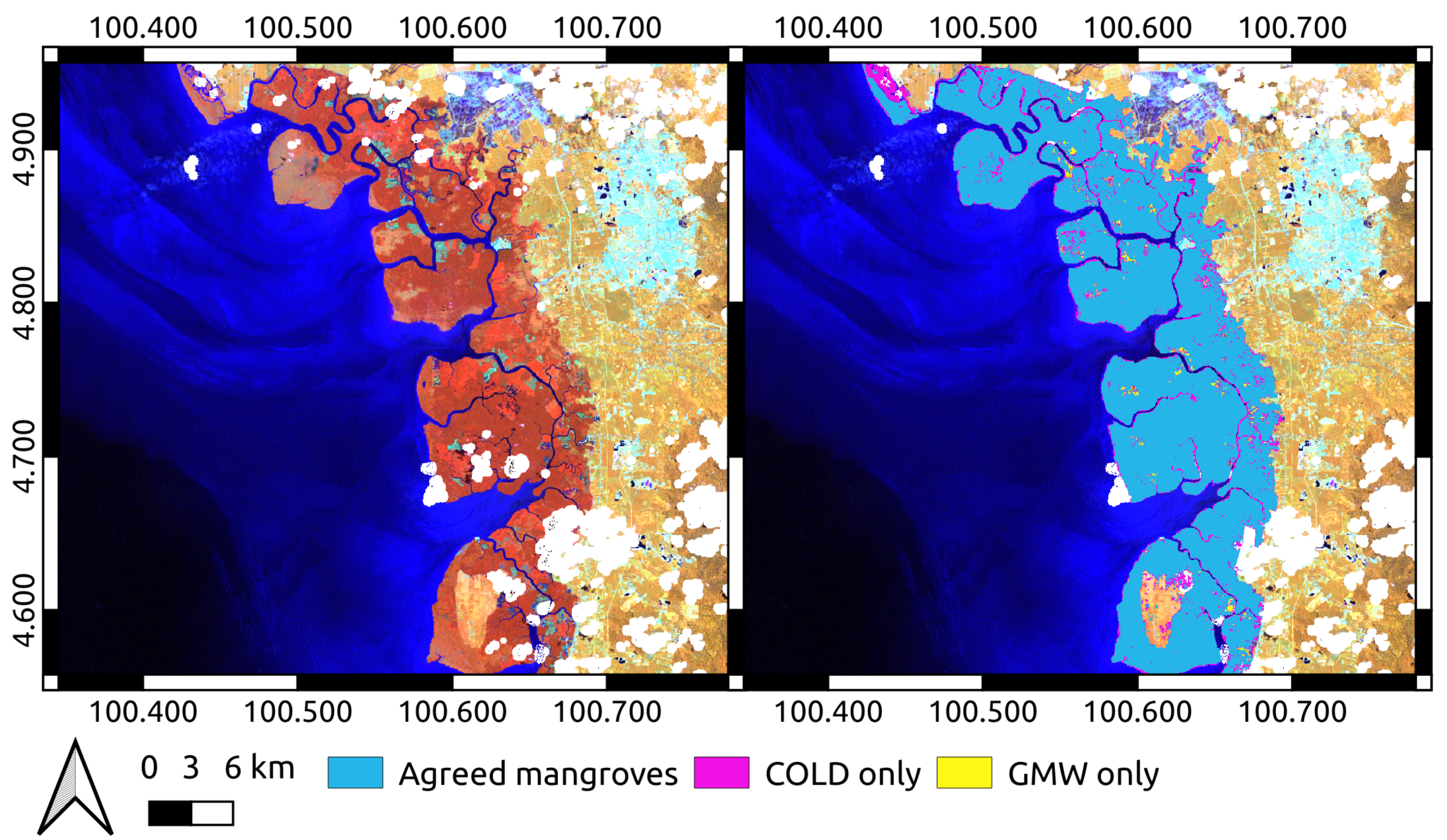


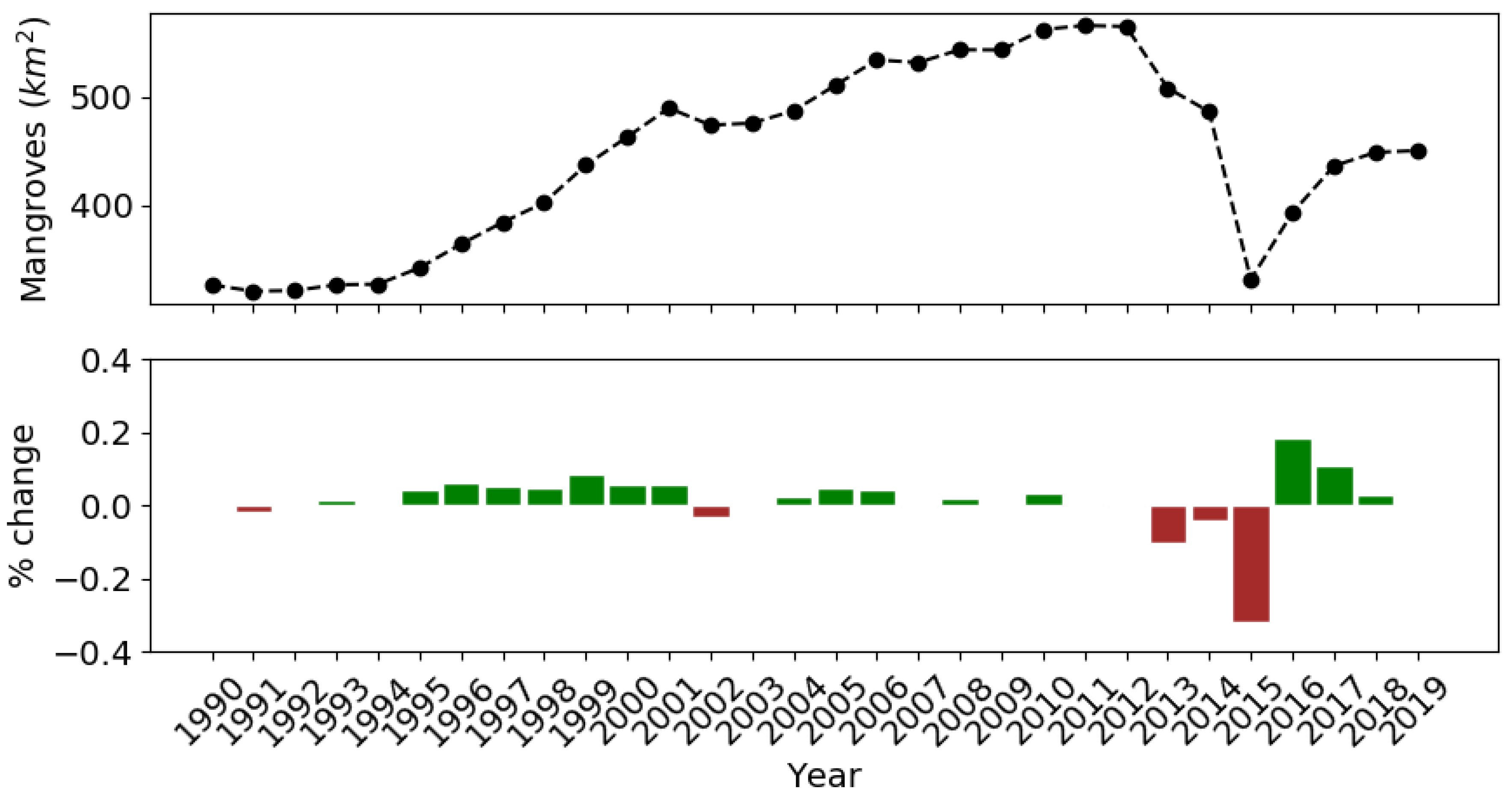
| Study Site | Path/Row | Rainfall (mm/year) | Species | No. of Scenes |
|---|---|---|---|---|
| Niger Delta | 189/57 | 3000–4500 [14,33] | Rhizophora racemosa, R. mangle, R. harrisonii [34,35] | 163 |
| French Guiana | 227/57 | 2000–3000 [36,37] | Avicennia germinans, Laguncularia racemosa, Rhizophora sp. [36,38] | 203 |
| Borneo | 117/58 | 1800–3000 [39,40] | Avicennia sp., Sonneratia sp. [40,41] | 392 |
| Malaysia | 128/57 | 2000–2800 [42,43] | Rhizophora apiculata, Rhizophora mucronata [44,45] | 605 |
| Australia | 99/72 | 600–1800 [46] | Avicennia marina, Rhizophora stylosa [46,47] | 890 |
| Study Site | Other Land | Water | Mangroves | Total |
|---|---|---|---|---|
| Niger Delta | 217,348 | 422,090 | 413,954 | 1,053,392 |
| French Guiana | 310,546 | 477,790 | 204,861 | 993,197 |
| Borneo | 315,859 | 497,380 | 269,027 | 1,082,266 |
| Malaysia | 248,994 | 499,396 | 465,032 | 1,213,422 |
| Australia | 91,057 | 457,280 | 227,171 | 775,508 |
| Total | 1,183,804 | 2,353,936 | 1,580,045 | 5,117,785 |
| Reference | ||||||
|---|---|---|---|---|---|---|
| Mangrove | Water | Other | Total | User’s (%) | ||
| Classifier | Mangrove | 3398 | 153 | 863 | 4414 | 77.0 |
| Water | 156 | 14,727 | 1448 | 16,331 | 90.2 | |
| Other | 128 | 56 | 13,627 | 13,811 | 98.7 | |
| Total | 3682 | 14,936 | 15,938 | 34,556 | ||
| Producer’s (%) | 92.3 | 98.6 | 85.5 | 92.7 |
| Reference | ||||||
|---|---|---|---|---|---|---|
| Mangrove | Water | Other | Total | User’s (%) | ||
| Classifier | Mangrove | 1026 | 29 | 41 | 1096 | 93.6 |
| Water | 3 | 2537 | 2 | 2542 | 99.8 | |
| Other | 24 | 12 | 2131 | 2167 | 98.3 | |
| Total | 1053 | 2578 | 2174 | 5805 | ||
| Producer’s (%) | 97.4 | 98.4 | 98.0 | 98.1 |
| Reference | ||||||
|---|---|---|---|---|---|---|
| Mangrove | Water | Other | Total | User’s (%) | ||
| Classifier | Mangrove | 504 | 35 | 285 | 824 | 61.2 |
| Water | 16 | 3272 | 20 | 3308 | 98.9 | |
| Other | 34 | 8 | 3330 | 3372 | 98.8 | |
| Total | 554 | 3315 | 3635 | 7504 | ||
| Producer’s (%) | 91.0 | 98.7 | 91.6 | 96.0 |
| Reference | ||||||
|---|---|---|---|---|---|---|
| Mangrove | Water | Other | Total | User’s (%) | ||
| Classifier | Mangrove | 434 | 45 | 390 | 869 | 49.9 |
| Water | 46 | 2892 | 206 | 3144 | 92.0 | |
| Other | 11 | 17 | 2640 | 2668 | 99.0 | |
| Total | 491 | 2954 | 3236 | 6681 | ||
| Producer’s (%) | 88.4 | 97.9 | 81.6 | 92.3 |
| Reference | ||||||
|---|---|---|---|---|---|---|
| Mangrove | Water | Other | Total | User’s (%) | ||
| Classifier | Mangrove | 1089 | 37 | 65 | 1191 | 91.4 |
| Water | 19 | 3035 | 30 | 3084 | 98.4 | |
| Other | 22 | 6 | 2654 | 2682 | 99.0 | |
| Total | 1130 | 3078 | 2749 | 6957 | ||
| Producer’s (%) | 96.4 | 98.6 | 96.5 | 97.5 |
| Reference | ||||||
|---|---|---|---|---|---|---|
| Mangrove | Water | Other | Total | User’s (%) | ||
| Classifier | Mangrove | 345 | 7 | 82 | 343 | 79.5 |
| Water | 72 | 2991 | 1190 | 4253 | 70.3 | |
| Other | 37 | 13 | 2872 | 2922 | 98.3 | |
| Total | 454 | 3011 | 4144 | 7609 | ||
| Producer’s (%) | 76.0 | 99.3 | 69.3 | 86.1 |
Publisher’s Note: MDPI stays neutral with regard to jurisdictional claims in published maps and institutional affiliations. |
© 2021 by the authors. Licensee MDPI, Basel, Switzerland. This article is an open access article distributed under the terms and conditions of the Creative Commons Attribution (CC BY) license (https://creativecommons.org/licenses/by/4.0/).
Share and Cite
Awty-Carroll, K.; Bunting, P.; Hardy, A.; Bell, G. Evaluation of the Continuous Monitoring of Land Disturbance Algorithm for Large-Scale Mangrove Classification. Remote Sens. 2021, 13, 3978. https://doi.org/10.3390/rs13193978
Awty-Carroll K, Bunting P, Hardy A, Bell G. Evaluation of the Continuous Monitoring of Land Disturbance Algorithm for Large-Scale Mangrove Classification. Remote Sensing. 2021; 13(19):3978. https://doi.org/10.3390/rs13193978
Chicago/Turabian StyleAwty-Carroll, Katie, Pete Bunting, Andy Hardy, and Gemma Bell. 2021. "Evaluation of the Continuous Monitoring of Land Disturbance Algorithm for Large-Scale Mangrove Classification" Remote Sensing 13, no. 19: 3978. https://doi.org/10.3390/rs13193978
APA StyleAwty-Carroll, K., Bunting, P., Hardy, A., & Bell, G. (2021). Evaluation of the Continuous Monitoring of Land Disturbance Algorithm for Large-Scale Mangrove Classification. Remote Sensing, 13(19), 3978. https://doi.org/10.3390/rs13193978








